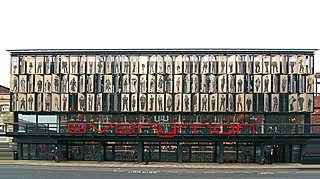
The Everyman Theatre stands at the north end of Hope Street, Liverpool, Merseyside, England. It was founded in 1964, in Hope Hall, in an area of Liverpool noted for its bohemian environment and political edge, and quickly built a reputation for ground-breaking work. The Everyman was completely rebuilt between 2011 and 2014.
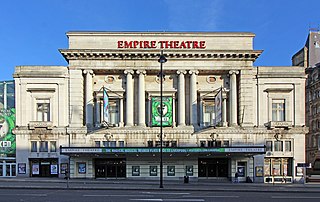
The Liverpool Empire Theatre is a theatre on the corner of Lime Street in Liverpool, England. The playhouse, which opened in 1925, is the second one to be built on the site. It has the largest two-tier auditorium in the United Kingdom and can seat 2,348 people.
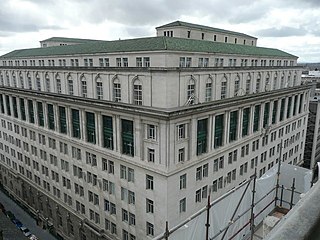
India Buildings is a commercial building with its principal entrance in Water Street, Liverpool, Merseyside, England. Mainly an office building, it also contained an internal shopping arcade and the entrance to an underground station. It was built between 1924 and 1932, damaged by a bomb in 1941, and later restored to its original condition under the supervision of one of its original architects. The building, its design influenced by the Italian Renaissance and incorporating features of the American Beaux-Arts style, occupies an entire block in the city.
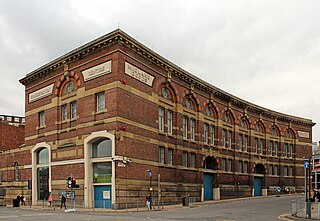
The National Conservation Centre, formerly the Midland Railway Goods Warehouse, is located in Liverpool, Merseyside, England. It stands in a block surrounded by Victoria Street, Crosshall Street, Whitechapel, and Peter Street. After it closed as a warehouse it was converted into a conservation centre for National Museums Liverpool in the 1990s. Initially its exhibition area was open to the public, but this closed in 2010. The centre is recorded in the National Heritage List for England as a designated Grade II listed building.

Capernwray Hall is a former country house situated 3 miles east-northeast of Carnforth, Lancashire, England, and is currently used as a Christian Bible school and holiday centre. The house is recorded in the National Heritage List for England as a designated Grade II* listed building. It stands in grounds included in the Register of Historic Parks and Gardens at Grade II.

The County Sessions House is a former courthouse in Liverpool, Merseyside, England. It stands at the bottom of Islington, to the east of the Walker Art Gallery, which now occupies the building. It is recorded in the National Heritage List for England as a designated Grade II* listed building.

The Aloft Liverpool Hotel, formerly the Royal Insurance Building, is a historic building located at 1-9 North John Street, Liverpool, Merseyside, England. It was built as the head office of the Royal Insurance company.

The Liverpool Medical Institution is a historic medical organisation based in Liverpool, United Kingdom. Its building on the corner of Mount Pleasant and Hope Street was opened in 1837, but the site has been used as a medical library since 1779.

Blackburne House is an 18th-century Grade II listed building located on the east side of Hope Street, Liverpool, Merseyside, England. Originally a private house, it became a girls' school and, after a period of dereliction, it is now used as a training and resource centre for women.
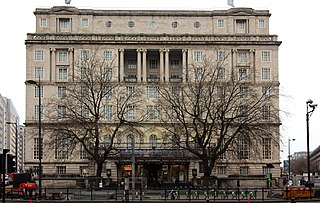
The Britannia Adelphi Hotel is in Ranelagh Place, Liverpool city centre, Merseyside, England. The present building is the third hotel on the site, and is recorded in the National Heritage List for England as a designated Grade II listed building. The building is owned and managed by Britannia Hotels. It contains 402 en-suite bedrooms, conference and dining facilities, and a gymnasium.
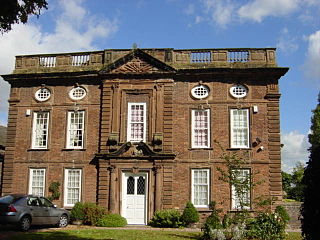
The Manor House, Hale is a house in Church End, Hale, a village in the borough of Halton, Cheshire, England. It is recorded in the National Heritage List for England as a designated Grade II* listed building.
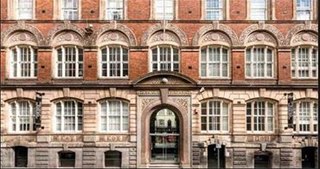
The Albany Building is a 19th-century Grade II* listed building located on Old Hall Street, in Liverpool, Merseyside, England. Built originally as a meeting place for cotton brokers, it has since been converted into apartments.

The State Insurance Building is at 14 Dale Street, Liverpool, Merseyside, England. Half of the building was destroyed by bombing in the Second World War. Both its external architecture and its internal decoration are elaborate.

The Liverpool, London and Globe Building is located in Dale Street, Liverpool, Merseyside, England. It fills a block adjacent to the Town Hall, bounded to the northeast by Exchange Street East and to the southwest by High Street.

The Church of St Vincent de Paul is a Roman Catholic parish church in St James Street, Liverpool, England. It is an active parish church in the Archdiocese of Liverpool and the Pastoral Area of Liverpool South. The church is recorded in the National Heritage List for England as a designated Grade II* listed building.
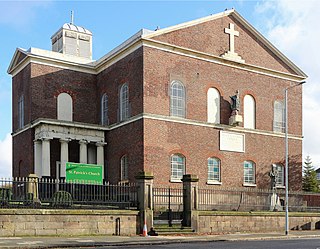
St Patrick's Church is a Roman Catholic parish church in Park Place, Liverpool, Merseyside, England. It is an active parish church in the Archdiocese of Liverpool and the Pastoral Area of Liverpool South. The church is recorded in the National Heritage List for England as a designated Grade II* listed building.

Southport Arts Centre, formerly known as Cambridge Hall, is on the east side of Lord Street, Southport, Sefton, Merseyside, England, and stands between Southport Town Hall and the Atkinson Art Gallery and Library. It was built in 1873–74 and originally contained an assembly hall. The centre contains mixed architectural styles and has a tall clock tower at the right end. During the 20th century the assembly hall was converted into a theatre, and it forms part of the arts complex known as The Atkinson. The arts centre is recorded in the National Heritage List for England as a designated Grade II listed building.

Ince Blundell Hall is a former country house near the village of Ince Blundell, in the Metropolitan Borough of Sefton, Merseyside, England. It was built between 1720 and 1750 for Robert Blundell, the lord of the manor, and was designed by Henry Sephton, a local mason-architect. Robert's son, Henry, was a collector of paintings and antiquities, and he built impressive structures in the grounds of the hall in which to house them. In the 19th century the estate passed to the Weld family. Thomas Weld Blundell modernised and expanded the house, and built an adjoining chapel. In the 1960s the house and estate were sold again, and have since been run as a nursing home by the Canonesses of St. Augustine of the Mercy of Jesus.
The Church of the Holy Family is attached to the service wing of Ince Blundell Hall, near the village of Ince Blundell, Sefton, Merseyside, England. It is both an estate church and an active Roman Catholic parish church in the Archdiocese of Liverpool. The church was built in 1858–60, it was designed by J. J. Scoles, and it contains paintings by Gebhard Flatz. It is recorded in the National Heritage List for England as a designated Grade II* listed building.

William Armstrong, CBE was a British actor, theatre manager and director, associated for many years with the Liverpool Playhouse, where as director he was an important influence on young actors in his company, including, at various times, Robert Donat, Robert Flemyng, Rex Harrison, Michael Redgrave and Diana Wynyard.

























